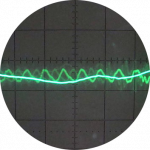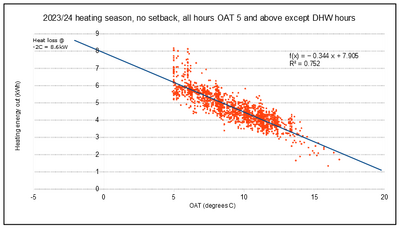https://renewableheatinghub.co.uk/forums/postid/48532/
Posted by: @pash44pumpSo now the question has changed completely. What should my new system look like? Obviously, bigger ASHP, no buffer tank just a system volumiser, pipework inside rather than outside (I've never liked it outside), different location for the ASHP? I really want to make sure the revamp is 100% right. Anyone have "what an ideal ASHP system should look like"?
If I were in your shoes I would absolutely want to get an independent handle on loss based on actual measurement given that, from what you have said, the value could drive significant design decisions which you would kick yourself if you get wrong. Can I suggest you refer back to this post and the few either side to remind yourself. Presumably you have 4 years of at least partial logs you might refer to. Otherwise what evidence do you have that the new survey is more accurate than the old?
Then in summary: No buffer, PHE or LLH, heat pump connected directly to emitters, volumiser in flow, no external controls not designed specifically for heat pumps (meaning only homely, havenwise or adia), 3 way diverter and antifreeze valves, no glycol. FRVs if you can, TRVs if you want but with the intention of opening up the vast majority so they have no effect. Heat pump ideally able to do programmed flow temperature set backs/set forwards natively (otherwise homely, havenwise). If its possible given your loss, avoid a cascade (2 heat pumps). In short, KISS.
4kW peak of solar PV since 2011; EV and a 1930s house which has been partially renovated to improve its efficiency. 7kW Vaillant heat pump.
Posted by: @pash44pumpAs you know, there was also a new Heat Loss Estimate at their expense as my calcs (thanks to the Freedom Heat Pumps model that @cathoderay shared, came out with 12.9kW). Today, I got a call from the installer as I chased the new HLE up and lo and behold. The new HLE shows a requirement of 14kW and I have a 12kW Midea.
Posted by: @pash44pumpAnother point, I'm thinking that if I've been running an underpowered ASHP for 4 winters, I have probably used way more power than I should have as my COP has probably been well below what it should have been. Any reasonable way I can quantify that?
Some things worth mentioning:
(1) the Headroom Heat Pump Heat Loss calculation is still just a calculation based on whatiffery. In the case of Midea heat pumps there is even some hidden whatiffery, depending on which version you use, because the Midea outputs were guesses, and the guesses tended to over-estimate output. You need to unhide the hidden parts of the spreadsheet to see all this.
(2) a 12kW Midea is also a 14kW Midea and even a 16kW Midea, or has been until recently, because the hardware is the same for all three, output is limited in the 12 and 14kW versions by dip switches. You mat already have a heat pump that can supply the necessary amount of heat.
(3) the last four winters with an underpowered heat pump: I don't think you will have used 'way more power', the problem is more that you can't use enough power (because the heat pump was too small) and the consequence is too cool a house, rather than too low a COP (though having to run at a high flow temps may affect that, as in higher flow temp = lower efficiency, all other things being equal)
(4) finally, and perhaps most importantly, amd this is what @jamespa was getting at above, if you also have four winters of ASHP data, then you can, if it is detailed enough, do an empirical ie measured heat loss assessment. In almost all cases, this will always trump a whatiffery based assessment. The basic idea is simple: when the IAT (indoor air temp, room temp) is stable, then the building is in heat balance, ie energy in = energy out. Thus by taking periods when the IAT is stable, and plotting OAT (outside air temp) against energy out (ie into the building), you have the heat loss over a range of different OATs. The relationship is effectively linear (for energy out), and once you have the plot, if it doesn't already reach the design OAT, say -2°C, then you extrapolate the line so it does.
But this does need at a minimum daily data for IAT (to check it is stable) plus mean OAT and energy out, which you may not have...but if you do, we can take you though how to do the plot. If you don't have the data, start collecting it now!
Midea 14kW (for now...) ASHP heating both building and DHW
@cathoderay and @jamespa - thanks for your replies. Unfortunately I don't have the last 4 years data. I bought the dataloggers at @cathoderay's recommendation and I therefore have the last 2 months of OAT and IAT (in my coldest room, which is the biggest space in the house). I also have electricity usage data for this period (as well as prior 18 months but with no IAT/OAT). @cathoderay can you explain what I should do next with what data I have in the dataloggers?
The "new" system will not get done until December at the earliest so I will have another couple of months for data collection. However, if the installer is offering a new 17kW heat pump and potentially changes to the rest of the spec, is there a downside to going down this route anyway? So that I understand, why do you advise against a cascade?
I take the points from @jamespa about system design and I have some questions.
Understand no buffer, PHE or LLH and need for system volumiser (on flow side). When you say heat pump connected directly to emitters, does than mean 2 zones - one for UFH and one for DHW with 3 way diverter valve inbetween?
Antifreeze valves and FRWs check. Anyone know if the Grant 17kW ASHP can do programmed set backs/set forwards natively. What are these for?
We would keep the room thermostats (just to see what the IATs are) but leave them at 28C in winter so that we are always calling for heat. The UFH manifolds would presumably need flow meters (which I don't currently have) as at current temperatures I have 1 living room 1-1.5 degrees hotter than average (as it has no external walls), bedrooms a bit hotter than I want by around 1.5 degrees and lounge 1 degree lower than I want (due to double height ceiling primarily). This is since I moved to WC which means everything is always fully open.
Many thanks
Pash
Posted by: @pash44pump@cathoderay can you explain what I should do next with what data I have in the dataloggers?
Four questions:
(1) what format is the data in? Hopefully csv or something that can be converted to csv?
(2) how frequent are the logged data points in each of the data sets (IAT OAT and energy in)?
(3) do you also have access to energy out ie supplied to the building and/or COP over the relevant time frame?
(4) are you comfortable manipulating and charting data in a spreadsheet (doesn't matter which one, just the general how to side of things)?
Given satisfactory replies to the above, I can give you a recipe. At the moment the period covered by your data is short, but the beauty of these monitoring systems is they just chug away in the background, forever collecting more and more data.
Edit - revisited my ability to count...
Midea 14kW (for now...) ASHP heating both building and DHW
Posted by: @pash44pumpThe "new" system will not get done until December at the earliest so I will have another couple of months for data collection. However, if the installer is offering a new 17kW heat pump and potentially changes to the rest of the spec, is there a downside to going down this route anyway? So that I understand, why do you advise against a cascade?
It depends on what the actual heat loss is, what the changes are and how disruptive they are. If the actual heat loss turns out to be 10kW (ie at the bottom end of the range estimated based on your oil consumption) then a 17kW heat pump is likely to be pretty inefficient, and it is also likely that you will end up doing unnecessary pipework upgrades. A cascade is extra hardware and complexity and more to go wrong, making it a more specialist system that will be more difficult to repair. You will also end up with much bigger rads than necessary and may find some are unwieldy. There is absolutely no substitute for knowing what the heat loss is and designing properly.
Your installer got it wrong the first time, so there is no particular reason to trust him. I am a little worried that he is simply going for broke on sizing because he hopes, rather than knows (because he has designed it properly), that it will fix your problems. If this is the case you could have a lot of work done and be no better off. An oversized heat pump wont fix things if that wasn't actually the problem! I am recommending you to protect yourself against this as much as is possible and getting a handle on loss is a good start.
You do need to be careful of course, you musn't take control of the design, he must retain responsibility. My recommendation is that, if anything doesnt make sense, you ask for a written explanation and express your concerns also in writing, without instructing him to do something that he doesn't think is right. Obviously if it does get to this point there is even more reason to be concerned.
Posted by: @pash44pumpUnderstand no buffer, PHE or LLH and need for system volumiser (on flow side). When you say heat pump connected directly to emitters, does than mean 2 zones - one for UFH and one for DHW with 3 way diverter valve inbetween?
Ideally rads and UFH both connected as a single entity (and run from the same water pump) with rads designed to operate at same temp as UFH. Yes a diverter valve for space vs dhw. You may well not need a volumiser, but it wont do any harm.
Posted by: @pash44pumpAnyone know if the Grant 17kW ASHP can do programmed set backs/set forwards natively. What are these for?
They are if you want it hotter at some times eg to take advantage of ToU tarrifs, or colder at sometimes (ditto or for comfort). I don't know if the Grant can do this, you will need to check the manual or possibly someone else knows.
Posted by: @pash44pumpThe UFH manifolds would presumably need flow meters (which I don't currently have)
If the flow meters also do flow regulation then yes. You will need flow regulation certainly.
-------
PS. I have skipped back through earlier posts and I think you said somewhere that it was heating ok (actually you said a bit too warm) except for the furthest rooms
I'm unclear whether this was true or not at the height of winter but if it is, then much more attention is needed to these. Increasing the ashp size won't help if the reason these aren't heating is insufficient emitter area or insufficient flow or both, with the latter masked by the former.
Some mass flow calculations needed here to ascertain that the pipework, to the extent it can be worked out, is actually adequate!
I remain to be convinced that your installers plan is not to oversize the pump so he knows it's big enough and can turn up the ft as high as is needed to 'solve' the problem. It will for sure, if you run at 65 or 70 the heat will get to the far end one way or another, but the running costs will be crippling so this isn't a solution you want. I apologise for my deep suspicion which may be totally unfounded.
4kW peak of solar PV since 2011; EV and a 1930s house which has been partially renovated to improve its efficiency. 7kW Vaillant heat pump.
@cathoderay I have whatever is stored on the dataloggers plus a csv of my half hourly usage in kWh. I think the RC4S capture hourly but I didn't configure them. I am fine with data manipulation.
Thanks
@pash44pump - pull the data from the data loggers and see what you actually have.
What you are aiming to do is plot hourly or daily mean OAT against hourly or daily energy out (to the house) when the house is in steady state. If you only have energy in, we will have to make assumptions about your COP to get energy out. The resulting plot should be linear, and (as you haven't got low OAT data yet) you will need to extrapolate to get the energy use at design temp. If you only have energy in (to the heat pump), the plot will have a gentle curve (because of decreasing COP at lower OATs).
You will almost certainly need to do some sort of 'inner join' (as in sql) with the data, as it comes from different sources, and it is unlikely the datetime stamps will be the same. If on the other hand they are all 'hourly on the hour' then life is a whole lot simpler, you just sort them and line them up in a spreadsheet. There is a very useful command line program I use when working with csv files called 'q - text as Data' that in effect means you can do sql on csv data which can make some of the data manipulation much easier.
You can also do all this in R or even python if you are more familiar with them, but most of the time a simple spreadsheet approach is more than adequate. Here's a plot I did a while back suggesting my heat loss is 8.6kW at -2°C OAT (I excluded low OATs because of defrost cycles), I think the true value may be nearer 9kW (this is not an exact science....). The Freedom calculator estimate was 12.3kW:
The key point is that with a heat loss of 9kW, give or take, my 11.3kW at around zero OAT Midea heat pump can just about cope with the loss, though defrost cycles at low OATs do play merry hell with things. If we were to believe the Freedom calculator, then the heat pump definitely CQC (can't quite cope).
The proof is in the pudding, or rather IAT, which I aim to have at 19-20°C. Here is a cold night from last February, with some pretty vicious defrost cycles (LWT way below the RWT):
In my dreams that night, I could hear the fat lady singing.
Midea 14kW (for now...) ASHP heating both building and DHW
@cathoderay thank you. I am away from home at the moment but when I return I will download the data from the dataloggers.
In terms of actual power usage, helpfully, I can now get all the data from my inverter which shows load consumption, grid use, PV generation, battery in/out etc. If I download this data I can match the actual load consumption to the OAT and IAT for each hour since the start of September and from now on. In order to get it, I have to run some script in Python (which I've never used).
Somone on my inverter/PV set-up has provided some script to run but it's proving difficult at the moment as I keep getting error messages (I was attempting to run it in JupyterLab) and the messages I'm getting from the forum seem to assume that I have a masters in Computer Science or something. Can I send you a PM with the script and see if you can help?
Basically, I just want somewhere that I can run the script and get going. Once I get in, I have script for specific queries. Many thanks
@pash44pump - it sounds as though you are close to having some useful data.
I avoid things like JupyterLab, they just seem to add another layer of complication. My python scripts are simple scripts that run on the command line (obviously you need to have python on the system). Python debugging can be a bit of a PITA, you get a load of error messages and have to tease out what the actual cause of the error is.
Yes, you can PM me, but I would prefer it if you posted the code here (redacted/amonymised as necessary if it contains sensitive information) and we discuss it here, as doing the stuff on the forum allows other interested members to follow along.
Midea 14kW (for now...) ASHP heating both building and DHW
@cathoderay hi there. I now have some data and wanted to do a trial run before I download any more to check that what I have is fit for purpose.
I have hourly OAT and IAT and energy in (i.e. total power load). I also have some data from when the ASHP was not doing anything (i.e hourly power load) so I know to a reasonable degree of accuracy, how much power is being used for DHW and how much is being used for running the house without DHW and heating (w machine, fridges, cooking, dishwasher etc).
So how do I calculate heat loss which is my next step? I mentioned the script which I run to get my power load but that is a specific to an API for Fox ESS Cloud which is my battery/inverter set up so unless someone wants it, I didn't plan to post it here.
I also know what my WC curve is in terms of LWTs but I'm not sure that will be needed for these calculations.
Thanks
On the new ASHP front, I have met the installers at my property. They are pushing to install 2 x 10kW Clivet heat pumps but I have told them I want a single ASHP with size to be determined (that's why these calculations will be helpful). They have agreed to put pipework indoors, lay a proper concrete base for the ASHP, fit antifreeze valves, flow meters on all the UFH manifolds and I'm still pushing back as they want to fit a buffer tank claiming that there wouldn't be sufficient system volume without one. So we are getting somewhere but still some work to do.
@pash44pump They want to fit a buffer tank to achieve a minimum volume of fluid? So why not a volumiser (2 port) instead? Regards, Toodles.
Toodles, heats his home with cold draughts and cooks food with magnets.
Posted by: @pash44pumpSo how do I calculate heat loss which is my next step?
Most of what you need is in my post above (15/10/2025 7:46 pm). You only need mean hourly (or daily if that is all you have) OAT and energy out, for periods when the IAT was stable. If you don't have energy out directly, you will have to estimate it from energy in, by applying your best guess of your COP eg if the energy in was 1kWh for the hour, and your COP is 3, then the energy out is 3kWh. You should ideally adjust the COP depending on OAT, as the COP will vary with OAT, I would use a nested IF function to do that.
Then set up a table with 4 columns: datetime (you may need to do some jiggery pokery to get them to match up for different data sources), OAT, energy out and IAT. Then sort by IAT so you get a chunk where the IAT is stable, and then chart (use a scatter plot) the energy out against OAT for that chunk, and then add a trend line along with trend line equation and R squared value. The use the equation to determine the energy at your design OAT, and that is your heat loss (strictly speaking the result is kWh but as it is over one hour is can also be expressed as kW: 10kWh over one hour is the same as 10kW for one hour).
You don't need your WCC parameters to do this, you just need a steady IAT (which is nonetheless achieved by having the right WCC).
Without seeing a sample of the actual data you have, I can't be more specific. If you can post a sample (with clear column headers ie what the column is, and units), then I might be able to be more specific. If you want to post any interim chart efforts, that might also help.
@toodles is on the money about the buffer tank: buffer tank no, volumiser yes, so long as it is needed. You can estimate the system volume from radiator volumes (from the manufacturer's catalogue) plus pipework volume to get a good enough estimate for this, and compare it to the heat pump's minimum system volume requirement.
Midea 14kW (for now...) ASHP heating both building and DHW
- 26 Forums
- 2,338 Topics
- 52.8 K Posts
- 254 Online
- 5,994 Members
Join Us!
Podcast Picks
Latest Posts
-
RE: What a Bad Heat Pump Installation Looks Like
I agree, except when it is an obvious health and safety...
By Batpred , 3 hours ago
-

RE: Replacing my 18 month old Hitachi Yutaki ASHP
I have been experimenting with different flow temperatu...
By trebor12345 , 4 hours ago
-
RE: Grant Aerona Short Cycling
@damonc I have been playing with this and it is pretty ...
By Grantmethestrength , 6 hours ago
-
RE: Havenwise App Help & Forum Support – Get the Most from Your Heat Pump
@hcas Hello Henri. It is disappointing, but I must pres...
By DavidAlgarve , 9 hours ago
-
RE: Home energy storage & battery register
I have Solax X1-AC with 5.8kWh. Last month we install...
By williamp , 12 hours ago
-
RE: Aira Heat Pump: Stylish Scandinavian Heating
Thanks @gmuzz @mikeh They still mention on the app t...
By ChandyKris , 16 hours ago
-
RE: Experience with Mitsu Par 50/60 Wireless Controller
The 27°C request doesn't boost the weather compensation...
By Sheriff Fatman , 1 day ago
-
RE: Getting the best out of a heat pump - is Homely a possible answer?
Oh and it was installed by Stevie Wonder!
By Grantmethestrength , 1 day ago
-
There seems to be plenty of evidence to support this. ...
By JamesPa , 2 days ago
-
RE: One Year Review: Grant 13kW ASHP - A Catalogue of Errors
@solenoid it sounds like you are making progress. No n...
By JamesPa , 2 days ago
-

RE: LiFePO4 lithium battery fires and explosions
@iaack — thanks, a useful video. They do make it clear...
By cathodeRay , 2 days ago
-
RE: How good is the app support for your heat pump?
I think you are right about the ebus stick. It's cert...
By JamesPa , 2 days ago
-

RE: My DIY Heat Pump installation
@majordennisbloodnok Element-ary my Dear Major.
By Toodles , 2 days ago
-

Welcome to the forums @isaac. What you’re describing is...
By Mars , 3 days ago
-

Win an Eve Smart Home Bundle worth over £350!
Win an Eve Smart Home Bundle worth over £350! ...
By Mars , 3 days ago
-
RE: Is your heat pump insured?
I chose Tesco in the end. Unambiguously cover HP, PV an...
By Davesoa , 3 days ago
-
RE: Help me keep the faith with my air source heat pump installation
@adamk You can get an idea of if your flow and return...
By SimonF , 3 days ago
-
This Solis inverter being rated 8kw and (I expect, as I...
By Batpred , 3 days ago







